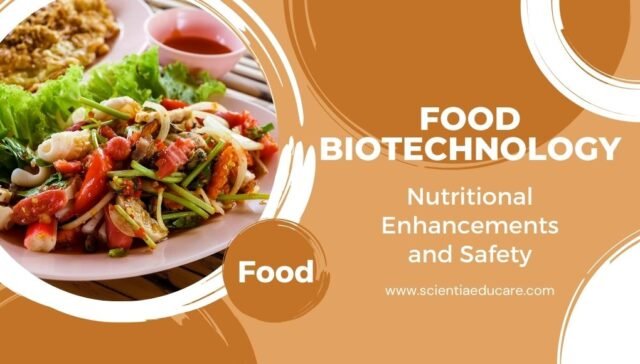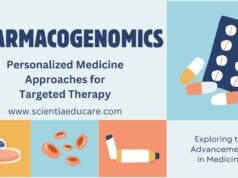Food Biotechnology: Advancements in Nutritional Enhancements and Ensuring Safety
Introduction
Food biotechnology is a rapidly evolving field that utilizes biological processes to enhance the nutritional value, safety, and sustainability of food. With advancements in genetic engineering, fermentation, and microbial applications, food biotechnology plays a crucial role in addressing global challenges such as malnutrition, food security, and foodborne illnesses. This study module explores the significant contributions of food biotechnology in nutritional enhancements and food safety.
Benefits of biofortified foods,
Role of probiotics in digestion,
Genetically modified food advantages,
Food biotechnology and nutrition,
Safe food biotechnology practices.
1. Understanding Food Biotechnology
Food biotechnology involves the use of technology to modify and improve food products through genetic engineering, fermentation, and microbial applications. It includes methods such as:
- Genetic modification (GM) – Altering the DNA of crops and animals to improve their quality.
- Microbial fermentation – Using bacteria, yeast, or fungi to enhance food preservation and nutritional properties.
- Synthetic biology – Creating new food components through biological synthesis.
Key Applications in Food Industry:
- Production of genetically modified crops (e.g., Golden Rice, Bt Corn).
- Development of probiotics and functional foods.
- Biofortification of staple foods.
- Enzyme applications for food processing.
- Enhanced food safety measures through microbial control.
2. Nutritional Enhancements through Food Biotechnology
One of the key objectives of food biotechnology is to improve the nutritional value of food products. Several techniques and strategies have been developed to address malnutrition and nutrient deficiencies.
A. Genetically Modified (GM) Crops for Nutrient Enhancement
GM crops have been developed to increase the nutritional profile of food:
- Golden Rice – Engineered to produce beta-carotene, a precursor of vitamin A.
- High-Iron and High-Zinc Crops – Enhancing micronutrient levels in staple foods like wheat and rice.
- Omega-3-Enriched Soybeans – Improving heart health by increasing omega-3 fatty acids in soybeans.
B. Probiotics and Functional Foods
Probiotics are beneficial bacteria that promote gut health and improve immunity:
- Yogurt with Probiotics – Contains Lactobacillus and Bifidobacterium strains to support digestion.
- Prebiotic Fibers – Enhancing beneficial gut bacteria through non-digestible fibers.
- Fortified Dairy and Plant-Based Products – Enriched with vitamins, minerals, and essential fatty acids.
C. Biofortification of Staple Foods
Biofortification enhances the nutrient content of crops through conventional breeding and biotechnology:
- Iron-rich beans and lentils – Addressing anemia in developing regions.
- Vitamin D-enriched mushrooms – Improving bone health and immunity.
- Protein-enriched cassava and maize – Beneficial for protein-deficient populations.
3. Ensuring Food Safety through Biotechnology
Food safety is a major concern worldwide, and biotechnology offers solutions to reduce contamination, prevent spoilage, and enhance traceability.
A. Detection and Elimination of Pathogens
Biotechnology enhances food safety through microbial detection and control measures:
- Genetically Engineered Microbes – Used for detecting contaminants in food processing.
- Bacteriophage Therapy – Targeting harmful bacteria like Salmonella and E. coli.
- Antimicrobial Peptides – Reducing foodborne pathogens in perishable products.
B. Biopreservation and Extended Shelf Life
Biopreservation techniques improve food safety and longevity:
- Lactic Acid Bacteria (LAB) in Fermented Foods – Prevents spoilage and improves microbial stability.
- Enzyme-Based Preservation – Enhancing shelf life of dairy and meat products.
- Natural Biopreservatives – Using organic acids and bacteriocins to inhibit microbial growth.
C. Traceability and Food Authentication
Advancements in biotechnology ensure food authenticity and safety through:
- DNA Barcoding – Identifying food sources and preventing adulteration.
- Blockchain and Bioinformatics – Enhancing transparency in the food supply chain.
- Edible RFID Tags – Tracking food quality and distribution.
4. Ethical Considerations and Public Perception
Although food biotechnology provides numerous benefits, there are concerns regarding its ethical and safety implications.
A. Consumer Concerns and Labeling Issues
- Transparency in GM food labeling.
- Ethical concerns over genetically modified animals.
- Public awareness and misconceptions regarding food biotechnology.
B. Environmental and Regulatory Aspects
- Impact on Biodiversity – Effects of GM crops on ecosystems.
- Stringent Regulatory Measures – Policies by FDA, EFSA, and WHO for food biotechnology approval.
- Sustainable Biotechnology Practices – Reducing chemical pesticide usage through GM crops.
5. Future Prospects of Food Biotechnology
Food biotechnology is expected to advance with innovations such as:
- CRISPR Gene Editing – Enhancing precision in genetic modifications.
- Lab-Grown Meat and Alternative Proteins – Sustainable protein sources.
- Plant-Based and Cultured Dairy – Eco-friendly dairy alternatives.
- Smart Packaging Technologies – Using biosensors to detect food spoilage.
6. Conclusion
Food biotechnology has revolutionized the food industry by enhancing nutrition and ensuring safety. With continuous research and technological advancements, it has the potential to address global food security challenges, improve human health, and promote sustainable agricultural practices.
7. Relevant Website URL Links
- World Health Organization (WHO) – Food Biotechnology: https://www.who.int/foodsafety
- Food and Agriculture Organization (FAO) – Biotechnology: https://www.fao.org/biotechnology/en/
- U.S. Food & Drug Administration (FDA) – Biotechnology: https://www.fda.gov/food/food-biotechnology
8. Further Reading
- National Center for Biotechnology Information (NCBI) – Food Biotechnology Research: https://www.ncbi.nlm.nih.gov
- European Food Safety Authority (EFSA) – GMO and Food Safety: https://www.efsa.europa.eu/en
- International Food Information Council (IFIC) – Food Biotechnology: https://www.foodinsight.org
MCQs on “Food Biotechnology: Nutritional Enhancements and Safety”
1. What is the primary goal of food biotechnology?
A) Increase food color and appearance
B) Enhance nutritional content and safety of food
C) Reduce food wastage only
D) Replace organic farming
✅ Answer: B) Enhance nutritional content and safety of food
Explanation: Food biotechnology focuses on improving food quality, increasing nutrient levels, and ensuring safety by reducing contaminants.
2. Which of the following is an example of a genetically modified (GM) crop with enhanced nutrition?
A) Bt Cotton
B) Golden Rice
C) Hybrid Wheat
D) Red Bananas
✅ Answer: B) Golden Rice
Explanation: Golden Rice is genetically modified to contain beta-carotene, a precursor of vitamin A, to combat vitamin A deficiency.
3. Which biotechnology technique is commonly used to introduce desirable genes into crops?
A) Polymerase Chain Reaction (PCR)
B) Gene Splicing
C) Chromatography
D) X-ray Crystallography
✅ Answer: B) Gene Splicing
Explanation: Gene splicing is a genetic engineering technique used to insert desirable traits into plants for better nutrition and resistance.
4. Which vitamin is enhanced in biofortified rice to prevent blindness?
A) Vitamin C
B) Vitamin A
C) Vitamin D
D) Vitamin E
✅ Answer: B) Vitamin A
Explanation: Golden Rice is engineered to produce beta-carotene, which the body converts into vitamin A, preventing deficiency-related blindness.
5. What is the main concern regarding genetically modified foods?
A) Increase in taste and flavor
B) Potential allergenicity and environmental impact
C) Higher production cost
D) Decrease in food availability
✅ Answer: B) Potential allergenicity and environmental impact
Explanation: Some concerns regarding GM foods include potential allergic reactions and the impact of altered genes on ecosystems.
6. Which of the following is NOT a method of food biotechnology?
A) Genetic engineering
B) Tissue culture
C) Fermentation
D) Pasteurization
✅ Answer: D) Pasteurization
Explanation: Pasteurization is a heat treatment process used to kill pathogens, not a biotechnological method for food modification.
7. What is the function of probiotics in food?
A) Kill harmful bacteria
B) Improve gut health by promoting beneficial bacteria
C) Increase food acidity
D) Enhance food color
✅ Answer: B) Improve gut health by promoting beneficial bacteria
Explanation: Probiotics, such as Lactobacillus and Bifidobacterium, help maintain a healthy gut microbiome.
8. Which mineral is enhanced in biofortified wheat to prevent anemia?
A) Calcium
B) Iron
C) Magnesium
D) Zinc
✅ Answer: B) Iron
Explanation: Biofortified wheat is engineered to have higher iron content to reduce the risk of iron-deficiency anemia.
9. What does HACCP stand for in food safety?
A) Hazard Analysis and Critical Control Points
B) High Accuracy Chemical Control Process
C) Healthy Agricultural Crop Certification Program
D) Human And Crop Cultivation Process
✅ Answer: A) Hazard Analysis and Critical Control Points
Explanation: HACCP is a systematic approach to food safety that identifies potential hazards and ensures food safety at critical points.
10. What is the key purpose of fortification in food biotechnology?
A) Increase shelf life
B) Enhance flavor
C) Improve nutritional content
D) Reduce cost
✅ Answer: C) Improve nutritional content
Explanation: Fortification involves adding essential vitamins and minerals to food to prevent nutrient deficiencies.
11. Which of the following is an example of a fermented food?
A) Bread
B) Yogurt
C) Pickles
D) All of the above
✅ Answer: D) All of the above
Explanation: Fermentation enhances food preservation, flavor, and nutritional benefits.
12. Which microorganism is widely used in dairy fermentation?
A) E. coli
B) Lactobacillus
C) Aspergillus
D) Pseudomonas
✅ Answer: B) Lactobacillus
Explanation: Lactobacillus is used in dairy fermentation to produce yogurt and cheese.
13. Which food safety measure prevents bacterial contamination?
A) Pasteurization
B) Genetic Modification
C) Food Coloring
D) Artificial Sweeteners
✅ Answer: A) Pasteurization
Explanation: Pasteurization kills harmful bacteria by heating food to a specific temperature.
14. Which enzyme is used in cheese production?
A) Amylase
B) Pepsin
C) Rennin
D) Lipase
✅ Answer: C) Rennin
Explanation: Rennin (or rennet) helps in coagulating milk during cheese production.
15. What is the role of prebiotics in food?
A) Provide energy
B) Enhance food color
C) Act as food for probiotics
D) Increase food preservation
✅ Answer: C) Act as food for probiotics
Explanation: Prebiotics help nourish beneficial gut bacteria and improve digestion.
16. Which disease can be prevented by iodine fortification in salt?
A) Diabetes
B) Goiter
C) Rickets
D) Scurvy
✅ Answer: B) Goiter
Explanation: Iodine deficiency causes goiter, which is prevented by iodized salt.
17. What is the primary safety concern in GM foods?
A) Increased protein content
B) Environmental impact and allergenicity
C) Higher market price
D) Reduced taste
✅ Answer: B) Environmental impact and allergenicity
Explanation: GM foods are scrutinized for potential allergies and effects on biodiversity.
18. Which vitamin is added to milk to prevent rickets?
A) Vitamin A
B) Vitamin B12
C) Vitamin C
D) Vitamin D
✅ Answer: D) Vitamin D
Explanation: Vitamin D fortification in milk helps in calcium absorption and prevents rickets.
19. What is the role of genetic engineering in food biotechnology?
A) Reduce food production
B) Improve taste only
C) Increase nutrient content and resistance to pests
D) Increase food waste
✅ Answer: C) Increase nutrient content and resistance to pests
Explanation: Genetic engineering enhances food quality and agricultural sustainability.
20. What is aflatoxin, a major food safety concern?
A) A protein enhancer
B) A toxic compound produced by fungi
C) A vitamin supplement
D) A type of pesticide
✅ Answer: B) A toxic compound produced by fungi
Explanation: Aflatoxins, produced by Aspergillus fungi, contaminate grains and nuts.














